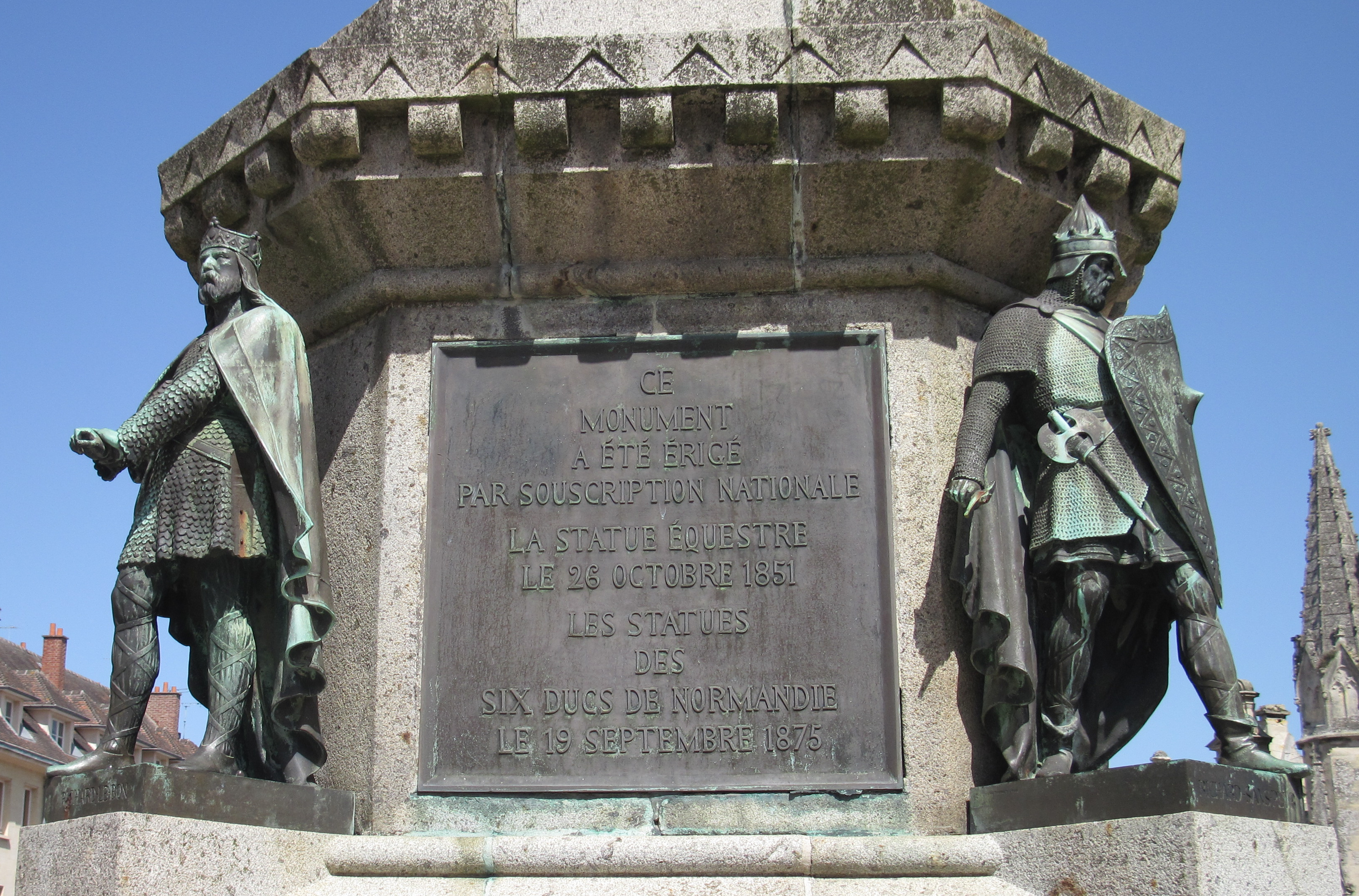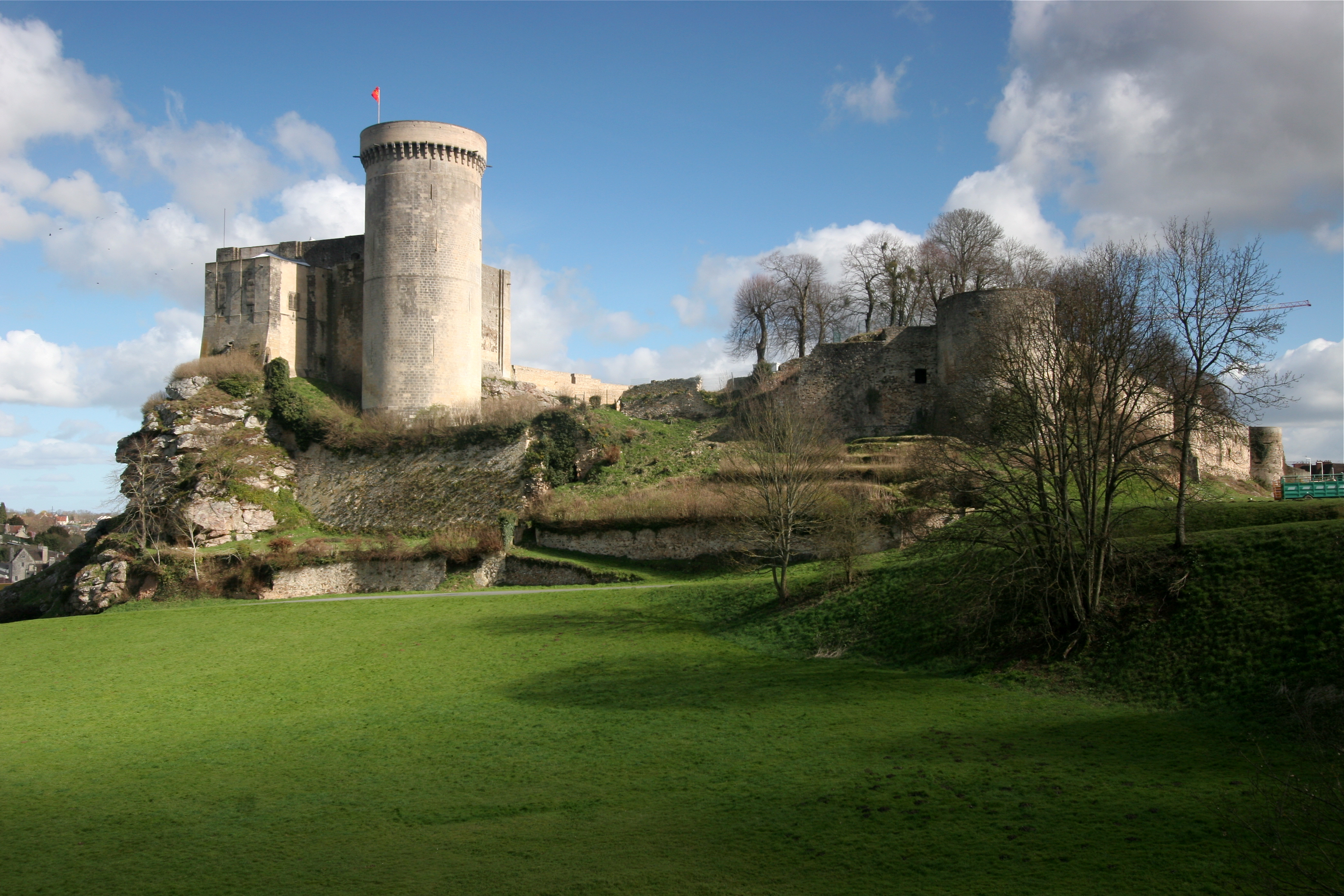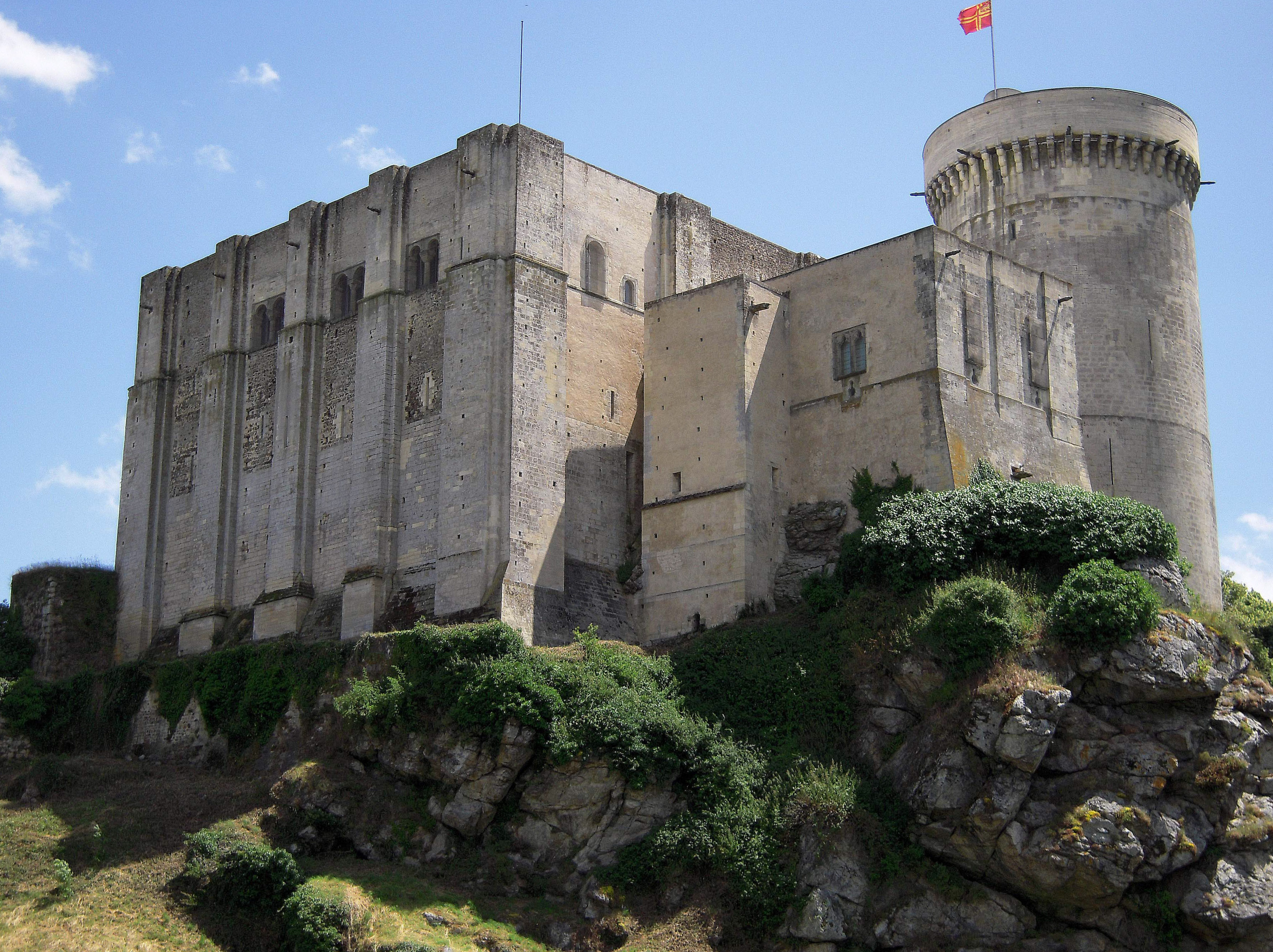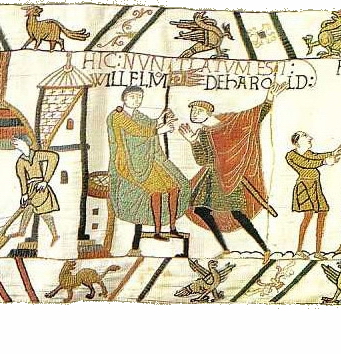|
Statue Of William The Conqueror
The statue of William the Conqueror is located in his birthplace, Falaise, Calvados, about 30 kilometres (19 miles) southeast of Caen, France. It depicts William the Conqueror, Duke of Normandy and King of England, on a horse, and is surrounded by statues of his six ducal predecessors. It is the work of the French sculptor . Description The monument is a bronze statue on a granite pedestal. Surrounding the pedestal are six other statues representing the first six dukes of Normandy: Rollo, William I, Richard I, Richard II, Richard III, and Robert I. There is also a commemorative plaque. William carries a gonfalon (banner) donated by Pope Alexander II. The sculptor, in order to make the work appear realistic, based his design on the Bayeux tapestry. Created with the help of a national subscription, it was unveiled on October 26, 1851. The six other statues are a later addition of September 19, 1875. Rollon Falaise (Calvados).jpg, Rollo William longsword statue in falaise.JPG, Wi ... [...More Info...] [...Related Items...] OR: [Wikipedia] [Google] [Baidu] |
Falaise, Calvados
Falaise () is a commune in the Calvados department in the Normandy region in northwestern France. Geography Falaise lies on the river Ante, a tributary of the river Dives, about southeast of Caen. History The area around Falaise has been inhabited from prehistoric times, but it was only at the end of the prehistoric period and the beginning of the Gallo-Roman era that the area, Falaise in particular, was regularly inhabited. Evidence of settlement from the time has been found at Vaston, an agricultural area just north-east of the modern town. Falaise, as it is sited today, probably came into being around the castle. The town was the birthplace of William the Conqueror, first of the Norman Kings of England. He was frequently referred to as William the Bastard, on account of his being born out of wedlock to Herleva from Falaise, reputedly a tanner's daughter. The Château de Falaise (12th–13th century), which overlooks the town from a high crag (french: falaise), was ... [...More Info...] [...Related Items...] OR: [Wikipedia] [Google] [Baidu] |
Richard III Of Normandy
Richard III (997/1001 – 6 August 1027) was the duke of Normandy who reigned from August 1026 to his death. His brief reign opened with a revolt by his brother. Life Richard III was the eldest son of Richard II of Normandy and Judith of Brittany. Around 1026, Richard was sent by his father in command of a large army to rescue his brother-in-law, Reginald, later Count of Burgundy, by attacking bishop and count Hugh of Chalon, who had captured and imprisoned Reginald in Chalon-sur-Saône. When Richard II died in August 1026, his eldest son, Richard III became Duke of Normandy. Shortly after his reign began his brother Robert, discontented with his province of Hiemois on the border of Normandy, revolted against his brother. He laid siege to the town of Falaise, but was soon brought to heel by Richard who captured him, then released him on his oath of fealty. No sooner had Richard disbanded his army and returned to Rouen, when he died suddenly (some say suspiciously). The duchy pas ... [...More Info...] [...Related Items...] OR: [Wikipedia] [Google] [Baidu] |
Equestrian Statues In France , the fictional nation in which the television s ...
The word equestrian is a reference to equestrianism, or horseback riding, derived from Latin ' and ', "horse". Horseback riding (or Riding in British English) Examples of this are: *Equestrian sports *Equestrian order, one of the upper classes in ancient Rome *Equestrian statue, a statue of a leader on horseback *Equestrian nomads, one of various nomadic or semi-nomadic ethnic groups whose culture places special emphasis on horse breeding and riding *Equestrian at the Summer Olympics, a division of Olympic Games competition Other *The ship ''Equestrian'', used to transport convicts from England to Australia, for example Alfred Dancey. See also *Equestria, Pretoria *Equestria Equestria () is the fictional setting of the fourth and fifth generations of the My Little Pony toy line and media franchise, including the animated television series '' My Little Pony: Friendship Is Magic'' and '' My Little Pony: Pony Life''. ... [...More Info...] [...Related Items...] OR: [Wikipedia] [Google] [Baidu] |
Tourist Attractions In Calvados (department)
Tourism is travel for pleasure or business; also the theory and practice of touring (other), touring, the business of attracting, accommodating, and entertaining tourists, and the business of operating tour (other), tours. The World Tourism Organization defines tourism more generally, in terms which go "beyond the common perception of tourism as being limited to holiday activity only", as people "travelling to and staying in places outside their usual environment for not more than one consecutive year for leisure and not less than 24 hours, business and other purposes". Tourism can be Domestic tourism, domestic (within the traveller's own country) or International tourism, international, and international tourism has both incoming and outgoing implications on a country's balance of payments. Tourism numbers declined as a result of a strong economic slowdown (the late-2000s recession) between the second half of 2008 and the end of 2009, and in consequence of t ... [...More Info...] [...Related Items...] OR: [Wikipedia] [Google] [Baidu] |
Cultural Depictions Of William The Conqueror
William I of England has been depicted in a number of modern works. In drama, film and television William I has appeared as a character in only a few stage and screen productions. The one-act play ''A Choice of Kings'' by John Mortimer deals with his deception of Harold after the latter's shipwreck. Julian Glover portrayed him in a 1966 TV adaptation of this play in the ITV Play of the Week series. William has also been portrayed on screen by Thayer Roberts in the 1955 film ''Lady Godiva of Coventry'', John Carson in the 1965 BBC TV series ''Hereward the Wake'', Alan Dobie in the two-part 1966 BBC TV play ''Conquest'' (part of the series ''Theatre 625''), and Michael Gambon in the 1990 TV drama ''Blood Royal: William the Conqueror''. Films about William's life include the 1982 French/Romanian production ''"William the Conqueror"'' (aka ''Guillaume le Conquérant'' or ''Wilhelm Cuceritorul''), directed by Sergiu Nicolaescu and Gilles Grangier, where Hervé Bellon played Will ... [...More Info...] [...Related Items...] OR: [Wikipedia] [Google] [Baidu] |
Falaise Place Guillaume-le-Conquérant , December 1174 between the captive William I, King of Scots, and the English King Henry II
{{disambig, geo ...
Falaise may refer to: Places * Falaise, Ardennes, France * Falaise, Calvados, France ** The Falaise pocket was the site of a battle in the Second World War * La Falaise, in the Yvelines ''département'', France * The Falaise escarpment in Quebec City, Canada * Falaise, Harry Guggenheim's Sands Point home Other * Treaty of Falaise The Treaty of Falaise was a forced written agreement made in December 1174 between the captive William I, King of Scots, and Henry II, King of England. During the Revolt of 1173-1174, William joined the rebels and was captured at the Battle of ... [...More Info...] [...Related Items...] OR: [Wikipedia] [Google] [Baidu] |
Château De Falaise
The Château de Falaise is a castle from the 12th-13th century, located in the south of the commune of Falaise ("cliff" in French) in the ''département'' of Calvados, in the region of Normandy, France. William the Conqueror, the son of Duke Robert of Normandy, was born at an earlier castle on the same site in about 1028. William went on to conquer England and become king, and possession of the castle descended through his heirs until the 13th century, when it was captured by King Philip II of France. Because of his association to the location (though not the existing physical structure) it is also known as Château Guillaume le Conquérant or William the Conqueror's Castle. Possession of the castle changed hands several times during the Hundred Years' War. The castle was abandoned during the 17th century. Since 1840 it has been protected as a '' monument historique''. History On the death of Richard II, Duke of Normandy, in August 1026 his son (also called Richard ... [...More Info...] [...Related Items...] OR: [Wikipedia] [Google] [Baidu] |
Statue D'Dgilliaume Lé Contchéthant à Falaise 17
A statue is a free-standing sculpture in which the realistic, full-length figures of persons or animals are carved or cast in a durable material such as wood, metal or stone. Typical statues are life-sized or close to life-size; a sculpture that represents persons or animals in full figure but that is small enough to lift and carry is a statuette or figurine, whilst one more than twice life-size is a colossal statue. Statues have been produced in many cultures from prehistory to the present; the oldest-known statue dating to about 30,000 years ago. Statues represent many different people and animals, real and mythical. Many statues are placed in public places as public art. The world's tallest statue, ''Statue of Unity'', is tall and is located near the Narmada dam in Gujarat, India. Color Ancient statues often show the bare surface of the material of which they are made. For example, many people associate Greek classical art with white marble sculpture, but there is evidenc ... [...More Info...] [...Related Items...] OR: [Wikipedia] [Google] [Baidu] |
Pope Alexander II
Pope Alexander II (1010/1015 – 21 April 1073), born Anselm of Baggio, was the head of the Roman Catholic Church and ruler of the Papal States from 1061 to his death in 1073. Born in Milan, Anselm was deeply involved in the Pataria reform movement. Elected according to the terms of his predecessor's bull, ''In nomine Domini'', Anselm's was the first election by the cardinals without the participation of the people and minor clergy of Rome. He also authorized the Norman Conquest of England in 1066. Early life and work Anselm was born in the parish of Cesano Boscone in the town of Corsico some 7 km (5 mi) from Milan of a noble family. The family took its name from Baggio. a suburb of Milan, where the family held the office of "captain". According to the ''Liber pontificalis'', his father's name was Anselmus or Ardericus. Contemporary sources do not provide any information on where Anselm might have obtained his education. It was traditionally believed that An ... [...More Info...] [...Related Items...] OR: [Wikipedia] [Google] [Baidu] |
Gonfalon
The gonfalon, gonfanon, gonfalone (from the early Italian language, Italian ''confalone'') is a type of heraldic flag or banner, often pointed, swallow-tailed, or with several streamers, and suspended from a crossbar in an identical manner to the ancient Roman vexillum. It was first adopted by Italian medieval communes, and later, by local guilds, corporations and districts. The difference between a gonfalon with long tails and a standard is that a gonfalon displays the device on the non-tailed area, and the standard displays badges down the whole length of the flag. Background A gonfalon can include a badge or coat of arms, or decoration. Today, every Italian comune (municipality) has a gonfalon sporting its coat of arms. The gonfalon has long been used for ecclesiastical ceremonies and processions. The papal "ombrellino", a symbol of the pope, is often mistakenly called "gonfalone" by the Italians because the pope's ceremonial umbrella was often depicted on the banner. ''Gonf ... [...More Info...] [...Related Items...] OR: [Wikipedia] [Google] [Baidu] |
Robert I Of Normandy
Robert the Magnificent (french: le Magnifique;He was also, although erroneously, said to have been called 'Robert the Devil' (french: le Diable). Robert I was never known by the nickname 'the devil' in his lifetime. 'Robert the Devil' was a fictional character who was confused with Robert I, Duke of Normandy sometime near the end of the Middle Ages. See: François Neveux, ''A Brief History of the Normans'', trans. Howard Curtis (Constable & Robinson, Ltd. London, 2008), p. 97 & n. 5. 22 June 1000 – 1–3 July 1035) was the duke of Normandy from 1027 until his death in 1035. Owing to uncertainty over the numbering of the dukes of Normandy he is usually called Robert I, but sometimes Robert II with his ancestor Rollo as Robert I. He was the son of Richard II and brother of Richard III, who preceded him as the duke. Less than a year after his father's death, Robert revolted against his brother's rule, but failed. He would later inherit Normandy after his brother's death. He was s ... [...More Info...] [...Related Items...] OR: [Wikipedia] [Google] [Baidu] |




